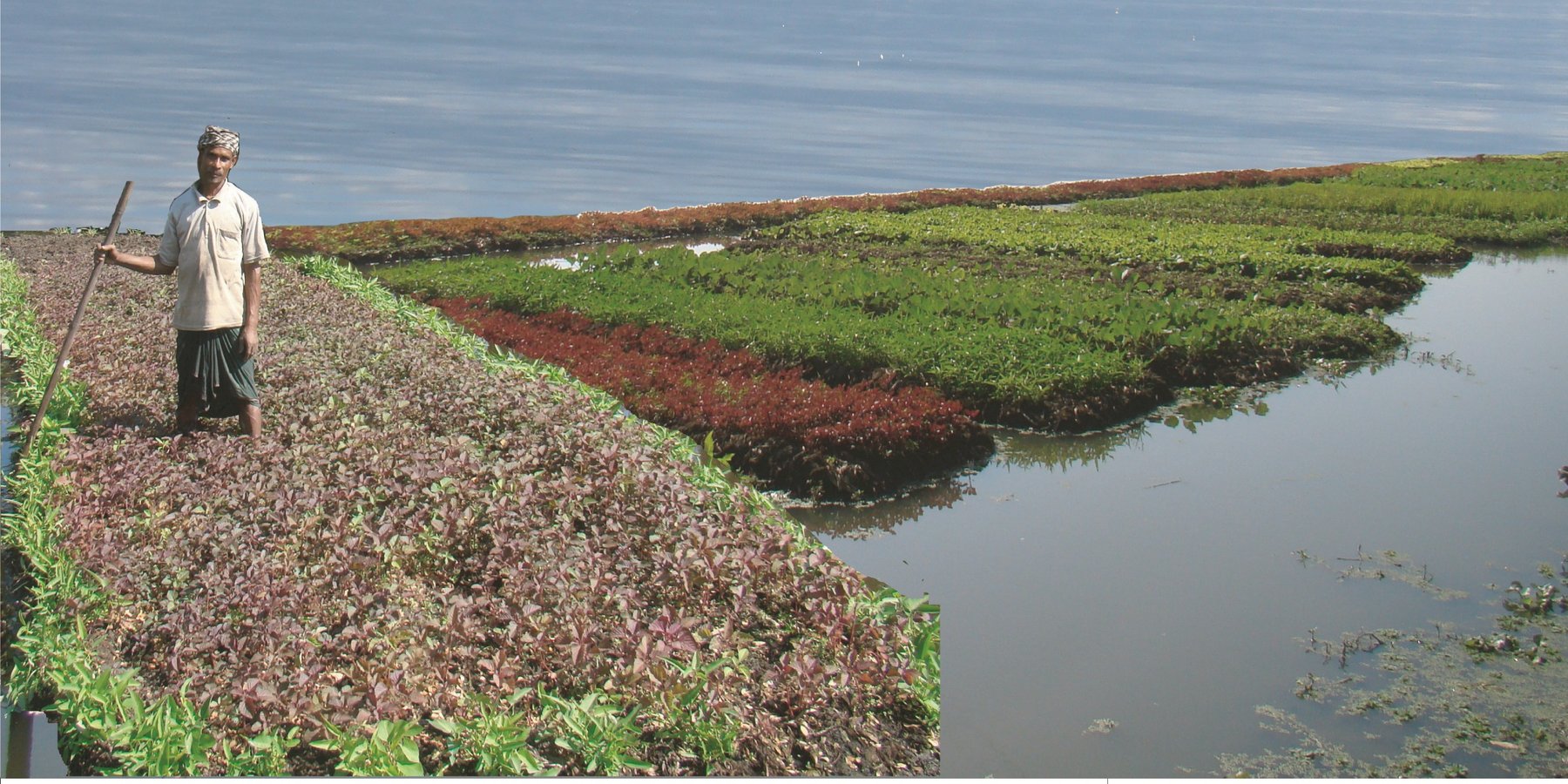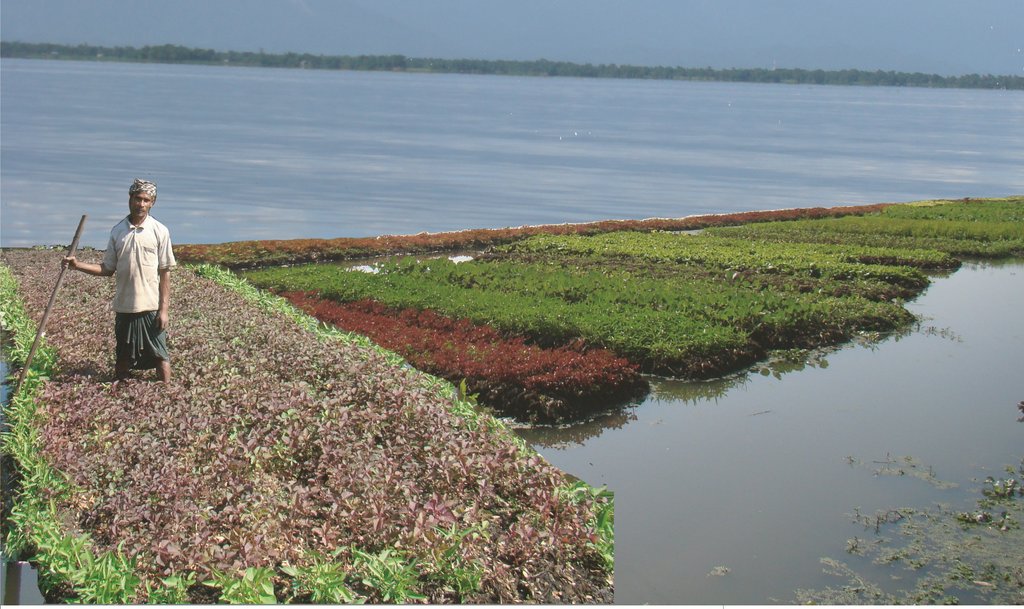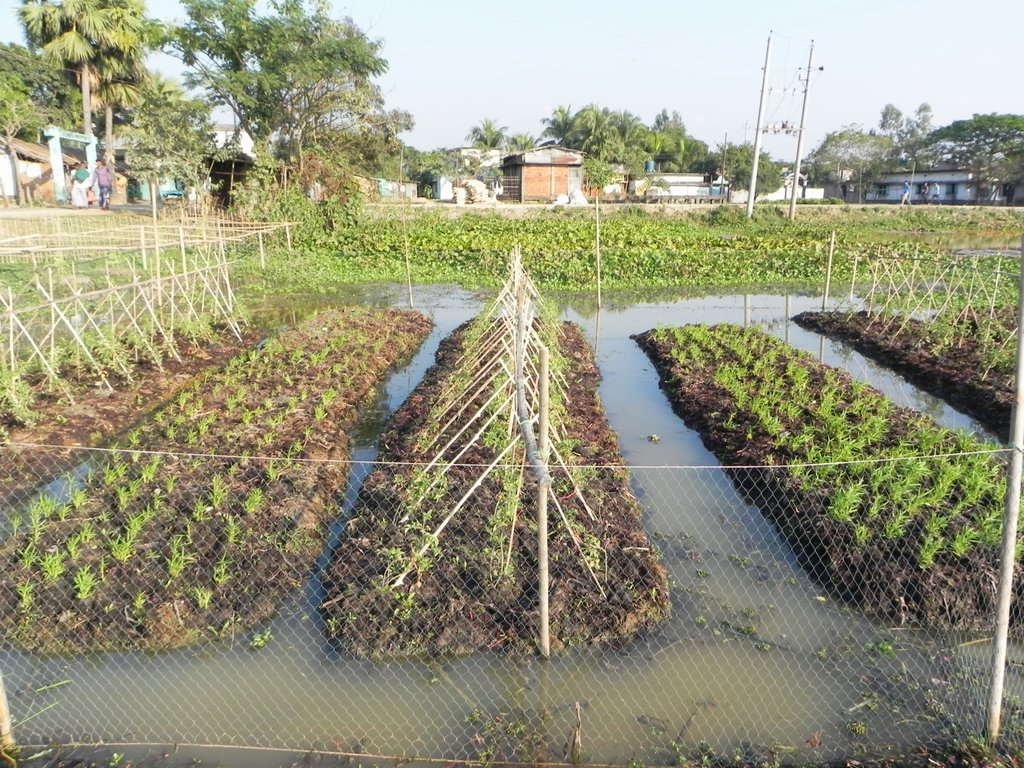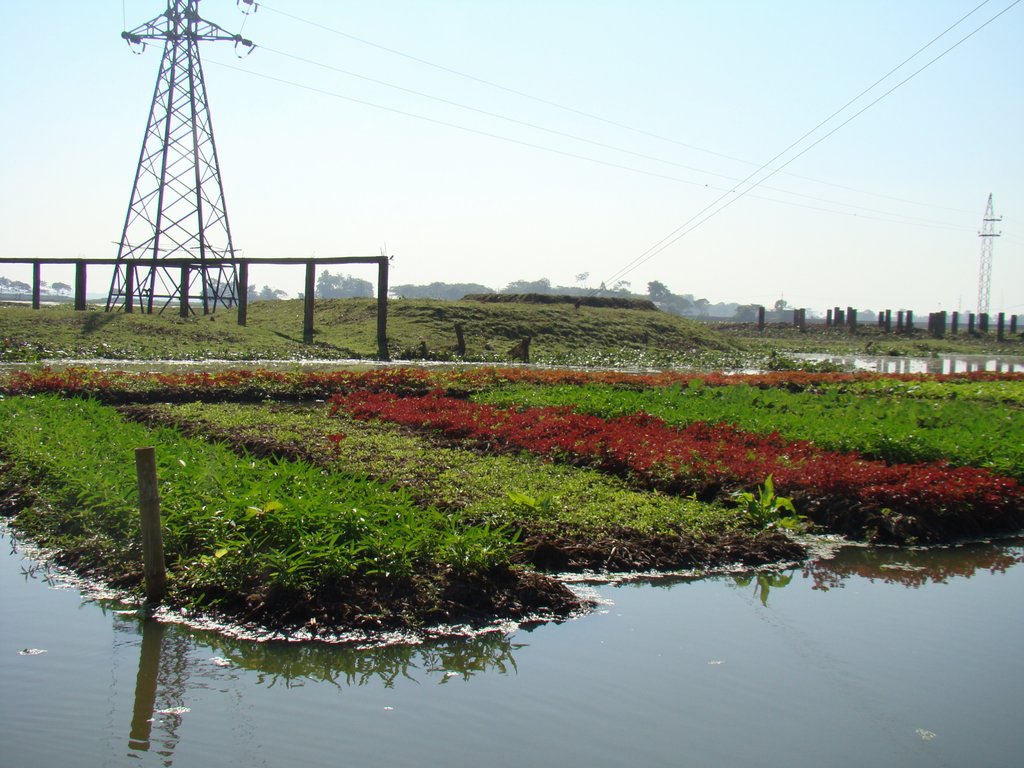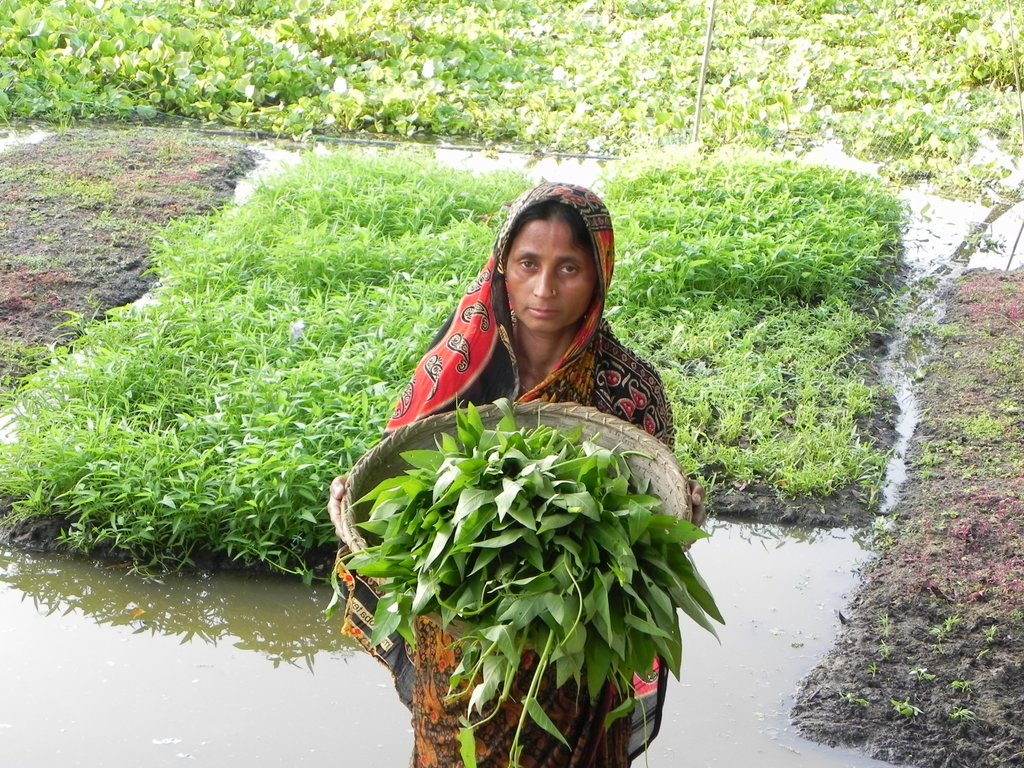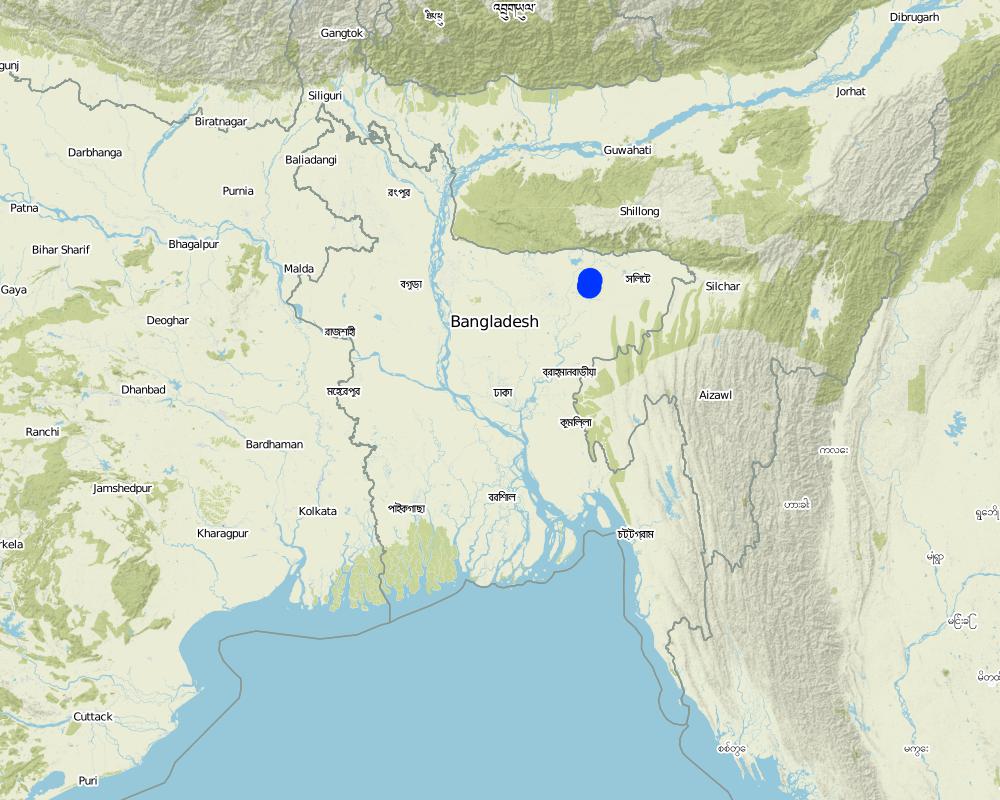Floating Garden [Бангладеш]
- Создание:
- Обновить:
- Составитель: Shamim Ahamed
- Редактор: Eveline Studer
- Рецензенты: Alvin Chandra, Alexandra Gavilano
"Baira" or "Dhap", floating bed
technologies_620 - Бангладеш
Просмотреть разделы
Развернуть все Свернуть все1. Общая информация
1.2 Контактные данные специалистов и организаций, участвующих в описании и оценке Технологии
Ответственный (-ые) специалист (-ы)
Специалист по УЗП:
Hasan Md. Zahid
HELVETAS Swiss Intercooperation
Бангладеш
Название проекта, содействовавшего документированию/оценке Технологии (если применимо)
Book project: where people and their land are safer - A Compendium of Good Practices in Disaster Risk Reduction (DRR) (where people and their land are safer)Название организации (-ий), содействовавших документированию/оценке Технологии (если применимо)
HELVETAS (Swiss Intercooperation)1.3 Условия, регламентирующие использование данных, собранных ВОКАТ
Составитель и ответственный(-ые) специалист(-ы) согласны с условиями, регламентирующими использование собранных ВОКАТ данных:
Да
1.4 Декларация по устойчивости описываемой Технологии
Вызывает ли описанная здесь Технология проблемы деградации земель настолько, что ее нельзя назвать природосберегающей?
Нет
Пояснения:
Context specific environmentally friendly technology
2. Описание Технологии УЗП
2.1 Краткое описание Технологии
Определение Технологии:
Floating Garden is a traditional technology, practiced in the southern parts of Bangladesh locally called “Baira” or “Dhap”. The technology allows producing crops, vegetables and seedlings in areas where farming land is scarce and where the land is flodded or water logged for more than six months in a year.
2.2 Подробное описание Технологии
Описание:
Floating gardensa are a traditional practice in south central districts of Bangladesh since long time, and has been promoted by government extension agency and development organizations in different parts of the country with technical improvements. With this technology, crops (mainly vegetables) are cultivated on floating garden beds in areas where the land inundated for more than six months in a year.
Establishment:
The basic input and main raw material to prepare the floating garden bed are water hyacinths (Eichhornia crassipes). In some cases bamboo sticks are also used to make the floating beds more resistant. The floating gardens are of different size, with a standard size per bed during preparation of 1.5 - 1.8 meter wide, 10 -11 meter long and 1 - 1.3 meter above water level. However, considering local context- such as wave action, size of water body, presence of a wetland - the bed size may vary, also depending on whether compost is added on the top. The establishment of the floating gardens are very cheap in terms of raw material and require mainly human manual labour for its establishment, without material costs for maintenance.
The garden can be used for two purposes: for vegetable production and for vegetable seedling production.
In water logged areas (where water remains for the whole year) floating beds are mainly used for vegetable production. Almost any type of vegetables can be grown in the floating bed. Production of leafy vegetables proofed to be most profitable. In addition, all types of vegetable seedlings and rice seedlings can produced in floating garden based on demand. In other areas, which are only inundated temporarily, floating garden can be used for both vegetable and seedling production. In this second case seedlings can be transfered from the garden to the fields on the main land immediately after receding of the water. This practice can save 2 to 3 weeks time of vegetable or rice production in winter season. This is a crucial advantage considering the trend to shorter growing periods due to unpredictable early spring rains.
A key advantage of floating gardening is the fact that heavy rainfalls usually do not have any negative effect on culture of the floating gardens, which are a highly effective and beneficial risk reduction and climate change mitigation technology. Floating gardens can further contribute to food security and improved nutrition for poor households, and it is a source for additional income by making use of cheap and abundant local input resources. Different NGOs improved and promoted this technology in north-west and north-east parts of Bangladesh since 2000. Since 2011 also the public agricultural extension agencies promote this technology.
As an overall goal this technology aims at protecting people’s assets for agricultural production from damages due to seasonal floods and provide options for alternative income resources. The floating garden technology is designed as measure to protect effectively from yearly floods. It might not be robust enough for extreme events with heavy storms and waves. Smaller repairing can be done by the owners themselves. In case of major damages the beds can be replaced by new ones, since the investment costs are very low. In the shallow areas the floating beds may become ordinary garden beds or fields during dry season.
2.3 Фотографии, иллюстрирующие Технологию
2.4 Видеоматериалы, иллюстрирующие Технологию
Комментарий, краткое описание:
This video was developed for the capitalization of practical experience and instructive training materials. The short movie describes step by step the establishment and the benefits of the floating gardens. In a short interview governmental and other local partners share their positive experience of the technology and describe how the technology is mainstreamed by Government agencies.
The video is available online with following link: https://youtu.be/AK_qTm2pUsw
Дата:
29/02/2012
Место:
Sunamganj, Bangladesh
Автор съемки:
HELVETAS Swiss Intercooperation
Комментарий, краткое описание:
The video documentary was prepared to capitalise and diseminate the experience of the Floating Gardens as an innovative technology for vegetable cultivation in wetlands.
Дата:
01/06/2012
Место:
Sunamganj, Bangladesh
Автор съемки:
HELVETAS Swiss Intercoopartion
2.5 Страна/ регион/ места, где применяется Технология, информация о которых собрана в данной Анкете
Страна:
Бангладеш
Административная единица (Район/Область):
Sylhet division, Sunamganj district
Более точная привязка места:
Paschim Pagla, Patharia and Shimulbak unions under South Sunamganj sub-district, Charnarchar and Rajanagar unions under Derai sub-district
Охарактеризуйте пространственное распространение Технологии :
- примененяется точечно/ на небольших участках
Пояснения:
More than 1000 floating beds have been prepared in 8 sub-districts of Sunamganj district in northeastern Bangladesh and documented accordingly. HELVETAS supported government agencies (District Administration and Department of Agricultural Extension-DAE) to document and promote the technology further.
Map
×2.6 Сколько лет применяется данная Технология
Если год начала применения Технологии достоверно неизвестен, дайте примерную оценку:
- менее 10 лет назад (недавняя)
2.7 Внедрение Технологии
Укажите, как именно Технология УЗП была внедрена:
- через проекты/ внешнее вмешательство
Пояснения (тип проекта и т.д.):
The technology was first piloted through implementation of “Livelihoods, Empowerment and Agroforestry (LEAF)” project. Later on, the technology was expanded through implementation of “Agricultural Innovation for Eliminating Extreme Poverty” (AIEEP 2009-2012) and through Unnoti -Prosperity in Haor project (2013-2016).
3. Классификация Технологии УЗП
3.1 Основные цели и задачи реализации Технологии
- повышение производства
- снижение риска стихийных бедствий
- адаптация к изменению климата / экстремальным погодным явлениям и их последствиям
- создание благоприятных экономических условий
- создание благоприятных социальных условий
- improve household food security / nutrition
3.2 Текущий(-ие) тип(-ы) землепользования на территории, где применяется Технология

Пахотные угодья и плантации
- Однолетние культуры
Ежегодный урожай - Уточните культуры:
- овощи - листовые овощи (салаты, капуста, шпинат, другие)
- seedlings
Число урожаев за год:
- 2
Поясните:
Winter and early Summer

Водотоки, водные объекты, водно-болотные угодья
- Болота, водно-болотные угодья
Основные виды продукции/ услуг:
Vegetable, Seedling and Fishes
3.3 Изменилось ли использование земель в связи с внедрением Технологии?
Пояснения:
earlier these wetland areas were mainly fallow (not used for any productive purpose). During monsoon season, the waterbodies naturally count on fish reserves, which are captures by local farmers including landless poor. Water hyacinth of these wetlands were partially used as fodder, though most of it was decomposed naturally without use.
3.4 Водоснабжение
другое (например, паводковое):
- post-flooding
Пояснения:
Floating gardens are prepared on the water body, hence can absorb sufficient water without additional irrigation.
3.5 Категория УЗП, к которой относится Технология
- Улучшение почвенного/ растительного покрова
- Охрана/ управление водно-болотными угодьями
- приусадебные участки
3.6 Мероприятия УЗП, выполняемые в рамках Технологии

Агрономические мероприятия
- A5: Семенное хозяйство, селекция, применение улучшенных сортов

инженерные мероприятия
- И11: Другие

управленческие мероприятия
- У1: Смена типа землепользования
Пояснения:
floating beds, which are adapted to changing water levels (floods).
change of land/water management from pure wetlands to gardens.
3.7 Основные проблемы деградации земель, на решение которых направлена Технология

деградация водных ресурсов
- Вуп: изменение объема поверхностного стока
Пояснения:
More frequent and severe seasonal floodings
3.8 Предотвращение и снижение деградации земель, или восстановление нарушенных земель
Укажите цель Технологии по отношению к деградации земель :
- снижение деградации земель
- адаптация к деградации земель
Пояснения:
The technology is used to adapt to natural seasonal flooding, to prevent damages caused by floods by using wet lands for crop production.
4. Технические характеристики, мероприятия по практической реализации, вложения и стоимость
4.1 Технический рисунок, иллюстрирующий Технологию
Спецификация (пояснения к техническому рисунку):
• Dimensions: The floating beds are of different size. Standard size at the time of preparation 1.5 - 1.8 meter wide, 10-11 meter long and 1.0-1.3 meter height.
• Floating beds should not cover more than 30% area of the respective water body (wetland area) in order to keep enabling environment for other aquatic resources (e.g. fishes).
• Construction material used: The basic and main ingredient/material for the preparation of the floating garden are water hyacinths (Eichhornia crassipes). In some cases, bamboo sticks are also used to increase its resistance. If available, composts may be applied on the top of floating beds, though not compulsory.
Автор:
Shakila Chayan
Дата:
12/10/2016
4.2 Общая информация по необходимым вложениям и стоимости
Уточните, как рассчитывались затраты и вложения:
- на площадь, где применяется Технология
Укажите размер и единицу площади:
1 decimal for 5 floating beds
Если вы используете местные системы измерения, укажите коэффициент пересчета на один гектар (например, 1 га = 2,47 акров): 1 га =:
1 hectare = 247 decimals
другая/ национальная валюта (название):
BDT
Укажите среднюю дневную заработную плату наемных работников:
1 man-day cost BDT 300 (USD 3.85)
4.3 Мероприятия, необходимые для начала реализации
| Деятельность | Время (сессия) | |
|---|---|---|
| 1. | Bed preparation (by hired labour) | August-September |
| 2. | Seeding, care and maintenance, harvesting | September-March |
Пояснения:
After full harvesting of vegetable in March, the bed (decomposed water hyacinth) can be used as organic compost for other crops in cultivable land.
4.4 Вложения и затраты, необходимые для начала реализации
| Опишите затраты | Единица | Количество | Затраты на единицу | Общая стоимость на единицу | % затрат, оплаченных землепользователями | |
|---|---|---|---|---|---|---|
| Оплата труда | Hired labour cost for bed establishment | persons day | 10,0 | 300,0 | 3000,0 | |
| Оплата труда | Bed management cost (seeing, care, harvest ect.) | persons day | 90,0 | 300,0 | 27000,0 | 100,0 |
| Посадочный материал | Seeds per year | kg | 25,0 | 100,0 | 2500,0 | 100,0 |
| Строительные материалы | Bamboo | bamboo quantity | 2,0 | 100,0 | 200,0 | |
| Строительные материалы | Rope and lubricants | lumpsum | 1,0 | 250,0 | 250,0 | |
| Общая стоимость запуска Технологии | 32950,0 | |||||
| Общие затраты на создание Технологии в долларах США | 32950,0 | |||||
4.5 Поддержание/ текущее обслуживание
Пояснения:
No maintenance required
4.6 Стоимость поддержания/ текущего обслуживания ( в год)
Пояснения:
No specific maintenance costs during the year/season required. Small repairments are part of the labour costs of agronomic mesures to be done in paralele with care work.
4.7 Наиболее значимые факторы, влияющие на стоимость затрат
Опишите наиболее значимые факторы, влияющие на стоимость затрат:
In case the inputs, mainly water hyacinths, are not available at the selected sites, this increases the material and/or labour costs for hyacinths to be transported from distant locations.
All indicated costs refer to yearly costs, since the beds ususally have to be restablished every year.
5. Природные и социально-экономические условия
5.1 Климат
Среднегодовое количество осадков
- < 250 мм
- 251-500 мм
- 501-750 мм
- 751-1000 мм
- 1001-1500 мм
- 1501-2000 мм
- 2001-3000 мм
- 3001-4000 мм
- > 4000 мм
Укажите среднегодовое количество осадков (если известно), мм:
3365,00
Пояснения/ комментарии по осадкам:
The driest month is December, with 6 mm of rain. The greatest amount of precipitation occurs in June, with an average of 712 mm.
Укажите название соответствующей метеостанции:
Sunamganj, Bangladesh (data source: www.en.climate-data.org)
Агроклиматическая зона
- влажная
The average annual temperature is 25.0 °C in Sunamganj.
5.2 Рельеф
Склоны (преобладающие):
- пологие (0-2%)
- покатые (3-5%)
- покато-крутые (6-10%)
- крутые (11-15%)
- очень крутые (16-30%)
- чрезвычайно крутые (31-60%)
- обрывистые (>60%)
Формы рельефа:
- плато/ равнины
- гребни хребтов/холмов
- склоны гор
- склоны холмов
- подножья
- днища долин
Зона высотной поясности:
- 0-100 м над уровнем моря
- 101-500 м н.у.м.
- 501-1000 м н.у.м.
- 1001-1500 м н.у.м.
- 1501-2000 м н.у.м.
- 2001-2500 м н.у.м.
- 2501-3000 м н.у.м.
- 3001-4000 м н.у.м.
- > 4 тыс. м н.у.м.
Укажите, приурочено ли применение Технологии к специфическим условиям:
- в ситуациях вогнутого рельефа
5.3 Почвы
Если возможно, приложите полное описание почв или укажите доступную информацию, например тип почв, рH/ кислотность почв, ёмкость катионного обмена, содержание азота, содержание солей и т.д.
Not applicable for this technology as floating bed prepare on surface of water body
5.4 Доступность и качество воды
Уровень грунтовых вод:
на поверхности
Доступность поверхностных вод:
избыток
Качество воды (без обработки):
исключительно для сельскохозяйственного использования (орошение)
Является ли солёность воды проблемой?
Нет
Происходят ли периодические затопления территории?
Да
Регулярность:
часто
Комментарии и дополнительная информация по качеству и количеству воды:
Each year seasonal monsoon flooding. However, early flash (pre monsoon flood) occur only every 3 years.
5.5 Биоразнообразие
Видовое разнообразие:
- средняя
Разнообразие местообитаний:
- средняя
Комментарии и дополнительная информация по биоразнообразию:
Water bodies are rich with diverse aquatic organisms
5.6 Характеристика землепользователей, применяющих Технологию
Осёдлый или кочевой:
- Осёдлый
Рыночная ориентация производства:
- смешанный (натуральный / коммерческий)
Доходы из других источников:
- 10-50% всех доходов
Относительный уровень достатка:
- очень плохой
- плохой
Индивидуальное или коллективное хозяйство:
- частное/ домовладение
- группа/ община
Уровень механизации:
- ручной труд
Пол:
- женщины
- мужчины
Возраст землепользователей:
- молодёжь
- средний возраст
5.7 Средняя площадь земель, используемых землепользователями с применением Технологии
- < 0,5 га
- 0,5-1 га
- 1-2 га
- 2-5 га
- 5-15 га
- 15-50 га
- 50-100 га
- 100-500 га
- 500-1000 га
- 1000-10000 га
- > 10000 га
Считается ли это мелким, средним или крупным хозяйством (по местным масштабам)?
- мелкое
5.8 Собственность на землю, права на земле- и водопользование
Право водопользования:
- неограниченное (неконтролируемое)
- индивидуальное
Пояснения:
The farmers establish floating gardens in public water body and in private water body (with verbal agreement of water body owners).
5.9 Доступ к базовым услугам и инфраструктуре
медицинское обслуживание:
- плохой
- средний
- хорошая
образование:
- плохой
- средний
- хорошая
технические консультации:
- плохой
- средний
- хорошая
занятость (вне хозяйства):
- плохой
- средний
- хорошая
рынки:
- плохой
- средний
- хорошая
электроснабжение:
- плохой
- средний
- хорошая
транспорт и дорожная сеть:
- плохой
- средний
- хорошая
водоснабжение и канализация:
- плохой
- средний
- хорошая
финансовые услуги:
- плохой
- средний
- хорошая
6. Воздействия и заключительные положения
6.1 Влияние Технологии УЗП в пределах территории ее применения
Социально-экономическое воздействие
Продуктивность
производство сельскозяйственных культур
Комментарий/ пояснения:
crop production during rainy season becomes possible
площадь, используемая для производства продукции
Комментарий/ пояснения:
innundated fallow water bodies can be used for food production, which increases surface for production.
Доходы и затраты
доходы хозяйства
Комментарий/ пояснения:
People produce vegetable/seedlings and increase their cash income through selling of the production surplus in the market. It also provide food and additional nutrition support to the farm family. Consequently, poor farmer families increase their resilience to food insecurity and income fluctuation.
разнообразие источников дохода
Комментарий/ пояснения:
Additional income for floating gardeners, which is particularly valuable for poor i.e. landless people.
экономическое неравенство
Количество до применения УЗП :
0
Количество после применения УЗП:
1
объем работ
Комментарий/ пояснения:
slight but no significant increase in workload for bed preparation, care and harvesting
Социальное и культурное воздействие
продовольственная безопасность/ самообеспечение
Комментарий/ пояснения:
Vegetable production for home consumption contribute to households food security, which is particularly critical during rainiy season.
состояние здоровья
Комментарий/ пояснения:
Improved nutrition through household consumption of own vegetable production.
права на землю/воду
Комментарий/ пояснения:
People establish floating garden on public water bodies or individual water bodies, based on a (verbal) agreement and regulated by a free or rent.
культурные возможности
Комментарий/ пояснения:
Increase aesthetic view of wetlands, water becomes valuable productive surface with plants and flowers.
знания в области УЗП/ деградации земель
Комментарий/ пояснения:
Increased knowledge on disaster risk reduction technology, based on local resources and capacities adjusted to the situation of socially and economically disadvantaged groups.
положение социально и экономически уязвимых групп населения
Комментарий/ пояснения:
Its an simple "self-help" technology, which proveds new income options particularly for most vulnerable. It can be replicated by disadvantaged groups them-selfs landless and increases cohesion among the poor and very poor community members.
Экологическое воздействие
Биоразнообразие: растительность, животный мир
Растительный покров
Комментарий/ пояснения:
floating gardens increase vegetation coverage on the water surface
биомасса/ содержание углерода в надземной биомассе
Комментарий/ пояснения:
the material of old floating gardens, usualy at the end of the rainy season, are used as compost/ fertiliser for crop land.
разнообразие фауны
Комментарий/ пояснения:
With the floating gardens there are less water hyacinths spread over the surface, which increases sunlight and oxygen on the water. Hence, this contributes to good conditions for the growth of fish and other aquatic resources.
Климат и снижение риска стихийных бедствий
последствия наводнений
Комментарий/ пояснения:
Negative impacts due to floods, such as damages and limited production can be substantially reduced with this technology, which increases production and income during flooding period.
6.2 Влияние Технологии за пределами территории ее применения
ущерб прилегающим полям
Количество до применения УЗП :
0
Количество после применения УЗП:
1
Комментарий/ пояснения:
reduce/protect wave action and decrease soil erosion of the adjacent/raised land.
damage by wave erosion
Комментарий/ пояснения:
The floating gardens reduce wave erosion on neighbours' fields, since the beds protect adjacent land and assets from soil erosion.
Укажите оценку внешних воздействий (измерений) :
No specific research have been made on off-site and environmental impact of the floating garden technology.
6.3 Подверженность и чувствительность Технологии УЗП к постепенным изменениям климата и экстремальным погодным явлениям/ стихийным бедствиям, связанным с изменением климата (в понимании землепользователей)
Экстремальные явления, связанные с изменением климата (стихийные бедствия)
Гидрологические стихийные бедствия
| Насколько успешно Технология справляется с этим? | |
|---|---|
| регулярные наводнения (выход рек из берегов) | хорошо |
| паводки | очень хорошо |
Другие экстремальные климатические явления (стихийные бедствия)
| другое (поясните) | Насколько успешно Технология справляется с этим? |
|---|---|
| increasingly unpredictable start and duration of monsoon/rainy season, floods | умеренно |
Другие воздействия, связанные с изменением климата
Другие воздействия, связанные с изменением климата
| Насколько успешно Технология справляется с этим? | |
|---|---|
| увеличение вегетационного периода | хорошо |
Пояснения:
with the effect of climate change monsoon have become more impredictable: starting sooner, ending later.
The techology allows to plant and grow seedlings already before the end of rainy season, and can therefor mantain or even extend the growing period.
6.4 Анализ эффективности затрат
Насколько получаемый результат сопоставим с первоначальными вложениями (с точки зрения землепользователей)?
Эффективность затрат в краткосрочной перспективе:
позитивное
Эффективность затрат в долгосрочной перспективе:
слабо позитивное
Насколько получаемый результат сопоставим с текущими расходами по поддержанию технологии (с точки зрения землепользователей)?
Эффективность затрат в краткосрочной перспективе:
очень позитивное
Эффективность затрат в долгосрочной перспективе:
очень позитивное
Пояснения:
Considering only one season - particualrly for intensive raining seasons - the gardens have positive benefits.
Considering a longer time period with less intensive rainy seasons, the fact that the bed ususally have to be reestablished every year might require an important work from a land user's perspective (therefore rate with slightly less benefits)
6.5 Внедрение Технологии
- 1-10%
Если возможно, дайте количественную характеристику (число домохозяйств и/или площадь применения):
about 1000
Среди применяющих Технологию землепользователей, какова доля лиц, применяющих её по собственной инициативе, т.е. без какого-либо материального стимулирования со стороны?
- 11-50%
6.6 Адаптация
Была ли Технология УЗП изменена в недавнее время с целью адаптации к меняющимся условиям среды?
Нет
6.7 Сильные стороны/ преимущества/ возможности Технологии
| Сильные стороны/ преимущества/ возможности по мнению землепользователей |
|---|
| In the Haor area’ (local wetland ecosystem flooded during monsoon season) water hyacinths are naturally abundant. These are the basis and substrate for floating gardens. Hence, the technology makes use of local plants as resorces, as substrate of the floating garden. If required, floating bed can easily moved from one location to another. After preparation of the bed, no additional hard labour is required. |
| There is hardly pest infestation, therefore no use of pesticides is required. |
| After final harvest, the beds are used as organic compost for the fields. Further, the farmers either can sell or use the substrate of the garden as compost. |
| This simple technology and can easily be replicated. |
| During heavy rainfalls and storms, the crop are not damaged by floods since on a floating surface. |
| Сильные стороны/ преимущества/ возможности по мнению составителя или других ключевых специалистов |
|---|
|
Through this technology, crops can be produced on the water surface. The usually abundant water hyacinth are used as a productive resource, which increases the surface for crop production. In contexts, such as Bangladesh, where land resources are scarce this opens production options in public/abundant water bodies for landless farmers, who can earn money within a short period and with little investment. |
|
The production for home consumption improves nutrition, contributes to food security and surplus is sold at the market, which contribute to the income of poor households. The technology is useful for increasing production for home consumption and market. |
6.8 Слабые стороны/ недостатки/ риски Технологии и пути их преодоления
| Слабые стороны/ недостатки/ риски по мнению землепользователей | Возможные пути их преодоления/снижения? |
|---|---|
| In some cases there are water leeches available in the water body. Therefore, people become afraid of preparing floating beds. | People polish diesel/kerosene oil in their body before preparation of floating beds to protect them from attack of leeches. |
|
In some cases, water hyacinths are not available locally, consequently farmers face difficulties to prepare floating beds in distant places. Further challenges are the guarding/security of the gardens, the time consuming establishment of the beds. |
Introduce and prepare floating gardens by supporting whole groups instead of individual famers. |
| Wave action and local streams may drift away the floating beds | Use bamboo pole to fix floating beds and prevent that they are floating away. |
| Слабые стороны/ недостатки/ риски по мнению составителя или ответственных специалистов | Возможные пути их преодоления/снижения? |
|---|---|
| Non-availability of adequate quantity of water hyacinth in same place every year. | Prepare bed in the places where water hyacinth are available and then move the beds in to the desired locations. |
| Due to heavy wave action or heavy water flow, floating beds could be broken/destroyed. | Prepare small size beds. |
| Lack of awareness and willingness of farmers to practice this technology. | Organise meeting, training, demonstration, and learning visit. |
7. Справочные материалы и ссылки
7.1 Методы сбора/ источники информации
- выезды на места, полевые обследования
10 times field visits and 28 informants.
- опросы землепользователей
25
- опросы специалистов/экспертов по УЗП
4
Когда были собраны данные (на местах)?
05/10/2016
7.2 Ссылки на опубликованные материалы
Название, автор, год публикации, ISBN:
A learning documentary on Floating Vegetable Garden, HELVETAS Swiss Intercooperation, March-2012, ISBN: 978-984-33-5313-9
Где опубликовано? Стоимость?
https://youtu.be/AK_qTm2pUsw
Название, автор, год публикации, ISBN:
Innovative Vegetable Cultivation, HELVETAS Swiss Intercooperation, 2012
Где опубликовано? Стоимость?
https://youtu.be/lhiraDjPymU
Название, автор, год публикации, ISBN:
Piloting Schemes Systematic Integration of DRR in LEAF - December 2010
Где опубликовано? Стоимость?
https://assets.helvetas.org/downloads/drr_capex.pdf
7.3 Ссылки на соответствующую онлайн-информацию
Название/ описание:
A learning documentary on Floating Vegetable Garden, HELVETAS Swiss Intercooperation, March-2012, ISBN: 978-984-33-5313-9
Адрес в сети Интернет:
https://youtu.be/AK_qTm2pUsw
Название/ описание:
Innovative Vegetable Cultivation, HELVETAS Swiss Intercooperation, 2012
Адрес в сети Интернет:
https://youtu.be/lhiraDjPymU
Название/ описание:
Islam and Atkins, 2007. Indigenous floating cultivation: a sustainable agricultural practice in the wetlands of Bangladesh. Development in Practice 17:130-136.
Адрес в сети Интернет:
https://www.jstor.org/stable/25548185?seq=1#page_scan_tab_contents
Название/ описание:
Irfanullah et al., 2008. Introduction of floating gardening in the northeastern wetlands of Bangladesh for nutritional security and sustainable livelihood. Renewable Agriculture and Food Systems 23:89-96
Адрес в сети Интернет:
http://nopr.niscair.res.in/bitstream/123456789/11064/1/IJTK%2010(1)%2031-38.pdf
Название/ описание:
Irfanullah et al., 2011. Floating gardening in Bangladesh: a means to rebuild lives after devastating flood. Indian Journal of Traditional Knowledge 10:31-38.
Адрес в сети Интернет:
http://nopr.niscair.res.in/bitstream/123456789/11064/1/IJTK%2010(1)%2031-38.pdf
Название/ описание:
Irfanullah, 2013. Floating Gardening: a local lad becoming a climate celebrity? Clean Slate 88:26-27.
Адрес в сети Интернет:
http://floodresilience.net/solutions/item/floating-gardening-a-local-lad-becoming-a-climate-celebrity
Ссылки и модули
Развернуть все Свернуть всеСсылки
Нет ссылок
Модули
Нет модулей


